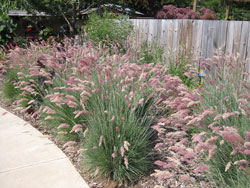Resource Library
Plant of the Week: Ruby Grass
The University of Arkansas System Division of Agriculture does not promote, support or recommend plants featured in "Plant of the Week." Please consult your local Extension office for plants suitable for your region.
Plant of the Week
Ruby Grass
Latin: Melinis nerviglumis

Big, bold perennial grasses have become popular in the last two decades, and their striking form makes them really stand out in the landscape scene. During this same period annual grasses have become more common in the flower garden, where their graceful form allows them to blend in with plants of a more flowery persuasion. One of the annual grasses making the rounds in recent years is ruby grass, Melinis nerviglumis.
Ruby grass is a tender perennial grass native to wide swaths of Africa, but it is also reported in areas surrounding the Indian Ocean and into warmer parts of Asia. It is a densely clumping grass with slender, erect growing, gray-green leaves that reach about 16 inches tall.
In mid- to late summer it begins sending up soft, fuzzy pink panicles about six inches long on stems up to two feet tall. Peak blooming time is late summer and early fall, when the clumps are awash in the pink panicles. As the panicles mature, they turn silvery white. The most common cultivar offered in the nursery trade is one called ‘Pink Crystals,' whose name aptly describes the effect produced when the flower heads are backlit by the sun.
Ruby grass has been grown for a number of years in botanical gardens, but its commercial debut seems to have occurred in 1998 when Colorado State University selected it as one of their Plant Select plants. A number of commercial growers picked it up and it is now more widely available, but still far from being commonplace.
Beauty is an allure for gardeners, but today there is more awareness amongst both consumers and nurserymen about a plant's potential for escape into the wild. Ruby grass' fluffy windborne seed make it a candidate for going native. In September of 2009 I saw it growing at low elevations along the steep embankments of the Copper Canyon railway in north-central Mexico. Our own USDA does not list it as "escaped" in the U.S., but the potential does exist for California, Texas and Florida.
As a grass, this plant is tough and easy to grown in sunny, reasonably fertile sites. While it survives drought and stress its garden performance, as reflected by fewer blooms, suffers unless given good care. For bedding-out, plant divisions after the danger of frost is past on 18 inch centers.
Escape in most of the Continental U.S. is unlikely because ruby grass is only winter hardy from zones 9 through 11. Seed germination is sporadic and difficult in the greenhouse, so the likelihood of it reseeding in a colder area is minimal. If escape is a concern, the seed heads could be clipped off when they begin changing colors. Commercially the plant is grown from clump divisions from plants that are overwintered in a greenhouse.
By: Gerald Klingaman, retired
Extension Horticulturist - Ornamentals
Extension News - October 30, 2009
The University of Arkansas System Division of Agriculture does not maintain lists of retail outlets where these plants can be purchased. Please check your local nursery or other retail outlets to ask about the availability of these plants for your growing area.